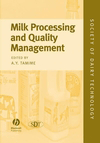Quality on the Line: Curing "The Monday Morning Blues"
A guide to reducing bacteria counts in dairy products produced following weekend or mid-week "down days"

Higher bacterial counts than normal in products produced after "down days" is not an infrequent occurrence. This condition is often referred to as the "Monday Morning Blues" and is the function of three contributing factors-raw milk quality; cleaning of equipment; and sanitizing of equipment.
Application of basic cleaning and sanitizing procedures will cure "The Monday Morning Blues."
Join Dr. Randolph and Associates for an Advanced Sanitation and Quality Workshop, Nov. 14 - 16, 2006. For registration information, contact Kristy Clark: 205/595-6455 or e-mail kmclark@randolphconsulting.com.

Higher bacterial counts than normal in products produced after "down days" is not an infrequent occurrence. This condition is often referred to as the "Monday Morning Blues" and is the function of three contributing factors-raw milk quality; cleaning of equipment; and sanitizing of equipment.
Raw milk
It is conceivable that milk processed on Monday morning after a weekend shut down could be as much as five days old before processing begins. This time lapse provides an opportunity for bacterial growth to take place. Raw milk should meet the following minimum standards:- No visible butterfat or evidence of churning at time of receiving;
- Temperature of 40°F or lower;
- Direct Microscopic Count (DMC)
- < 100,000 clumps per mL;
- Standard Plate Count (SPC) - <50,000 colonies per mL; and
- Preliminary Incubation Count (PI)
- < 100,000 colonies per mL.
Cleaning of equipment
Care should be taken every day, but especially before a "down day," to ensure that proper cleaning temperatures, times and concentrations are used. Any residual soils left on equipment surfaces, gaskets, and O-rings will support the growth of bacteria. The multiplication of bacteria is magnified by the extra time and ideal growth temperatures during "down days." Excessive numbers of bacteria will diminish the effectiveness of the sanitization process. Monitor the CIP system operation and manual cleaning procedures. Do not assume that all functions are operating properly. Dirty equipment cannot be sanitized. Check the following:- Be sure that tank outlet valve gaskets fit smoothly between tank face and valve body.
- Many tank agitators, sample valves, door gaskets and sight glasses must be removed, dismantled and manually cleaned.
- Gauge down tubes must be cleaned manually or by incorporating them in the CIP of the tank by use of a down tube adapting jumper.
- Check gauges and manometers for cracks and proper fit.
- Some pumps in the circuit may need to be completely disassembled and manually cleaned.
- Non-CIPable HTST vacuum breakers must be dismantled and manually cleaned.
- Filler valves and assemblies must be cleaned.
- Jug filler vent tubes must be manually brushed and COP cleaned.
Sanitizing of equipment
All equipment must be sanitized following cleaning and left in a sanitized condition during the "down day." All line circuits and filler bowls should be flooded with sanitizer and held over the "down day." Reminder: dirty equipment cannot be sanitized.Start-Up procedures
The following program/procedures should be considered as a means of "Curing the Monday Morning Blues:"- Rewash and resanitize all lines, tank circuits and fillers immediately before production. If rewashing and resanitizing is not possible, follow these steps:
- Drain sanitizer from line circuits and fillers.
- Sanitize all line circuits, tanks and fillers with recommended CIP sanitizer at ambient temperature. Overflow filler bowls with sanitizer and cycle filler and line valves. Sanitizer must remain in contact with lines and filler surfaces for at least five minutes.
- Spray the exterior of the filler bowl, valve assemblies, top breakers and formers, mandrels, transfers, and surrounding area with sanitizer.
- Drain sanitizer from milk lines and filler bowls and follow immediately with milk product.
- At least once per hour, clear cartons or jugs from the filler and spray the exterior surfaces of the filling equipment and surrounding area with sanitizer. Resume filling.
Application of basic cleaning and sanitizing procedures will cure "The Monday Morning Blues."
Join Dr. Randolph and Associates for an Advanced Sanitation and Quality Workshop, Nov. 14 - 16, 2006. For registration information, contact Kristy Clark: 205/595-6455 or e-mail kmclark@randolphconsulting.com.
Links
Looking for a reprint of this article?
From high-res PDFs to custom plaques, order your copy today!






